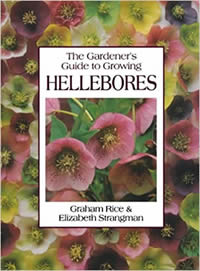I am noticing that the flower bud shoots for my hellebores (Helleborus x hybridus), are starting to push up above the soil surface. There is still a substantial stand of foliage in good condition.
My question is about pruning. I know I’ll need to prune about half the leaves away (I understand that the cut should be made at the base) to give the flowers more visibility. Does it harm the plant to prune it during this cold snap? Does it harm the plant to cut ALL the old leaves off in December as the bud stalks begin to appear?
I would appreciate any guidance you can give me, such as when and how extensively to prune them.
According to Hellebores: a Comprehensive Guide by C. Colston Burrell and Judith Knott Tyler, “all the hybrids maintain their foliage (…) throughout all or part of the winter (…) In any case, as the flower buds begin to stir in the center of the rosettes, it’s best to remove all the foliage to make way for the flowers. Nothing spoils the garden display like a tangle of flowers wrestling with winter-burned leaves. The juice is caustic and sometimes causes a rash, so take care when removing the old leaves.”
In The Gardener’s Guide to Growing Hellebores, Graham Rice and Elizabeth Strangman advise a more time-intensive method:
“The best approach is to cut off some leaves during the autumn and early winter when the garden is put to bed, concentrating on removing dead leaves and any showing signs of blackening (…) By Christmas time they should be thinned out sufficiently to leave a good circle. However, as our winters become windier it may be wise to remove them entirely at this stage. (…)Thin the leaves further as the flower stems emerge, then just before they are in full flower remove all the old leaves. (…) To compensate for the removal of the last of the leaves the plants deserve a good mulch.” They go on to suggest compost or a mulch of leaves for this purpose. The cold snap is unlikely to harm even recently pruned hellebores, as they seem to thrive in the cold.
 Once you’ve spent a pretty penny on a new hellebore you will want to protect your investment by learning exactly what they need to thrive. Read The Gardener’s Guide to Growing Hellebores by Graham Rice and Elizabeth Strangman for details on cultivation, propagation and essays on hellebore species and hybrids. Color pictures will whet your appetite for more of these delightful winter bloomers.
Once you’ve spent a pretty penny on a new hellebore you will want to protect your investment by learning exactly what they need to thrive. Read The Gardener’s Guide to Growing Hellebores by Graham Rice and Elizabeth Strangman for details on cultivation, propagation and essays on hellebore species and hybrids. Color pictures will whet your appetite for more of these delightful winter bloomers.